Everything you need to know about NASA CLPS Moon landing missions
A look at the armada of robotic landers NASA is riding to the Moon this decade.
NASA is returning humans to the Moon later in the decade, but a fleet of agency-supported robotic spacecraft will touch down on lunar soil starting this year. With its $2.6 billion Commercial Lunar Payloads Services (CLPS) initiative, NASA has been competitively funding commercial companies to build spacecraft that will autonomously land on the Moon, carrying with them the agency’s science and technology payloads to geologically diverse places.

Upcoming CLPS Moon landings
To date, NASA has funded several commercial companies for these CLPS Moon landing missions with the following contract values at the time of their selections:
- Mission 1, January 8, 2024: $79.5 million contract to Astrobotic
- Mission 2, February 12, 2024: $77 million contract to Intuitive Machines
- Mission 3, Late 2024: $47 million contract to Intuitive Machines
- Mission 4, 2024: $93.3 million contract to Firefly
- (Cancelled) Mission 5, November 2023: $75.9 million contract to Masten Space
- (Cancelled) Mission 6, November 2024: $226.5 million contract to Astrobotic (increased to $320.4 million for extra tests)
- Mission 7, 2025: $77.5 million contract to Intuitive Machines
- Mission 8, 2026: $73 million contract to Draper
- Mission 9, 2026: $112 million contract to Firefly
- Mission 10, 2025-26: $6.1 million to Blue Origin
- Mission 11, 2027: $116.9 million contract to Intuitive Machines
- Mission 12, 2028: $179 million contract to Firefly
Unlike traditional missions, these CLPS missions are fully built, operated and managed by their companies, with minimal oversight from NASA. The agency only dictates preferences for the landing sites, and the instruments it wants onboard.
These missions will also have non-NASA payloads from across the globe, something the agency encourages to spur a commercial lunar ecosystem. All landers on these missions will nominally last a maximum of one lunar day—that is, 14 Earth days—since frigid night time temperatures, well below -100 degrees Celsius, will render the solar- and battery-powered landers non-functional.
Astrobotic’s first CLPS mission

On January 8, 2024, Astrobotic’s lander launched with the aim of touching down in a lunar lava plain called Sinus Viscositatis just outside the Gruithuisen volcanic domes on February 23. The lander carried 15 payloads from 6 countries, including two micro-rovers. As part of NASA’s CLPS program, it was also supposed to carry 11 agency-funded instruments but flew only five of them. However, Astrobotic’s lunar lander failed before it could reach Luna, precluding a lunar descent attempt.
Intuitive Machines’ first CLPS mission
For its first CLPS mission named IM-1 which launched in February 2024, Intuitive Machines carried six NASA payloads to the Moon, attempting a soft landing in the polar Malapert A crater at 80°S. There was also a commercial telescope called ILO-X from Hawaii-based ILOA aboard. The company hit a hard-landing on the Moon instead but after which NASA and Intuitive Machines skewed the success criteria of the mission to claim is as successful.

Intuitive Machines’ second CLPS mission
March 2025 update: The spacecraft landed sideways and the mission failed
On its second Moon mission in Q1 2025, Intuitive Machines will deliver NASA’s PRIME-1 drill and a mass spectrometer at an optimum location on the Moon’s south pole where underground water ice is expected based on orbital data. The lander will drill up to 1 meter below the surface and analyze the soil for water ice, a first such study. The lander will also deploy Lunar Outpost’s MAPP rover on the surface to collect—but not bring back—lunar soil for NASA and also test Nokia’s 4G/LTE network on the Moon. Further, there’s the company’s own NASA-supported hopper onboard called Micro-Nova, which aims to hop five times to capture high-resolution imagery and other measurements of the surface under its flight path.

Masten’s first CLPS mission
Masten Space’s lander aimed to touchdown on the Moon’s south pole in November 2023. It was to have at least eight instruments onboard, chiefly to detect water ice and other volatiles such as methane and carbon dioxide to help us understand the Moon’s resource potential. The lander was also supposed to deploy Astrobotic’s shoebox-sized autonomous rover called MoonRanger. NASA even planned to put a neutron spectrometer onboard the rover to detect signs of water ice below the surface.
But following a Chapter 11 bankruptcy filing by Masten on September 13, 2022, the mission seems to have been rendered impossible. Astrobotic acquired Masten Space, including much of its space technology portfolio for $4.5 million. Debra Needham, Program Scientist at NASA’s Exploration Science Strategy and Integration Office, said at the 2023 annual LEAG meeting in September that the agency plans to “strategically manifest payloads” from Masten’s mission onto other landers as feasible.
VIPER rover delivery by Astrobotic
Astrobotic planned to launch NASA’s VIPER rover to the Moon’s south pole in November 2024 on a SpaceX Falcon Heavy rocket. VIPER was to explore areas in and around permanently shadowed regions for over 100 days, and use its drill and three instruments to unravel the nature of the Moon’s water ice deposits, assess their resource potential, and determine how accessible they are. This would’ve helped us plan future human missions to the Moon’s poles and eventually build sustainable habitats. On the same mission, ESA will fly a landing-precision-aiding camera, the first ever commercial delivery to the Moon contracted by the agency.
Given the mission’s criticality, NASA took a more conservative approach with VIPER compared to other CLPS contracts. The agency requested Astrobotic to delay VIPER’s delivery by a year, and contracted them $67.8 million to perform additional testing of the mission’s large, 5900-kilogram Griffin lander in order to reduce risk. At $320.4 million, VIPER was the most expensive CLPS delivery yet. Note that NASA separated its own costs to build and operate VIPER (currently at $433.5 million) from the payment to Astrobotic.
But in July 2024, NASA questionably cancelled the mission and has opted for a VIPER-less Artemis.

Firefly’s first CLPS mission

March 2025 update: Firefly successfully landed and performed scientific experiments 🚀
On January 15, a SpaceX Falcon 9 rocket successfully launched and deployed Firefly’s Blue Ghost lander in Earth orbit. It aims to descend in the lava plains of Mare Crisium at 18.56°N, 61.81°E in March 2025, carrying several NASA instruments to study the lunar environment.
One of the lander’s legs feature PlanetVac, a low-cost soil sampling technology partially funded by The Planetary Society to enable future sample return missions from the Moon, Mars and other planetary bodies. This mission will also be NASA’s first attempt to get a GPS lock from the Moon. The mission also has two commercial payloads.
Related: On the same launch as Blue Ghost, the Falcon 9 upper stage also deployed ispace Japan’s Hakuto-R lander to space. It’s carrying multiple commercial payloads. The mission follows up on the company’s first failed landing attempt but which did achieve lunar orbit.

Intuitive Machines’ third CLPS mission
Intuitive Machines’ third Moon landing will be in the swirl of Reiner Gamma in 2026. Reiner Gamma has a weak local magnetic field, possibly a remnant from the time the Moon had a global magnetic field. The mission’s primary payload suite Lunar Vertex is a collection of spectrometers and magnetometers on the lander and a rover to study the swirl’s composition, and map the strength and direction of magnetic fields on the surface. This will help us better understand the effects of solar wind and bombarding micrometeorites on planetary bodies across our Solar System, and also shape our understanding of the Moon’s magnetic evolution.
Relatedly, NASA has been testing variants of the three shoebox-sized CADRE rovers to be deployed at Reiner Gamma by the aforementioned lander. The rovers will autonomously navigate the landed region to demonstrate collectively better mapping it than a single rover would. The rovers will have multistatic ground penetrating radars to create 3D images of the subsurface structure up to 10 meters deep.
Draper’s farside CLPS mission
For its first CLPS mission in 2026, Draper will land a spacecraft made by ispace on the Moon’s farside, a feat only achieved by China’s Chang’e 4 mission so far. The landing region chosen by NASA for the mission is no less impressive—the 312 kilometers wide Schrödinger crater, the most pristine impact feature of its kind. The lander will carry 95 kilograms of NASA’s scientific instruments, which includes two highly sensitive seismometers, a drill, a probe, and a magnetic sounder, all to help us better understand the Moon’s internal structure and composition, and how our cosmic neighbor evolved. The lander will also carry LuSEE-Lite, which shielded from Earth’s radio noises on the farside makes it apt to study the solar wind’s interactions with the Moon’s surface.
Also see: How ispace, CLPS, funding, and science are interlocked
Firefly’s second CLPS mission

Firefly will deliver an orbiter and two surface payloads to the Moon in 2026. The company will use a similar lander design as its first CLPS mission but add a transfer stage to deliver the 280-kilogram Lunar Pathfinder orbiter for ESA in lunar orbit. Pathfinder is a stepping stone towards Moonlight, ESA’s upcoming commercial navigation and communications constellation. The Firefly lander itself will attempt a touchdown on the Moon’s farside carrying LuSEE-Night, a first of its kind instrument to measure faint but unique radio signals from our Universe’s ‘Dark Age’—a slice of time right before the first stars were born.
Firefly later won an extended $18 million contract from NASA to provide services for LuSEE-Night. The lander will host the “User Terminal” payload to enable LuSEE-Night to communicate to and fro Earth via the Elytra stage in lunar orbit. Elytra will also provide radio frequency calibrations for LuSEE-Night. In all, the two LuSEE payloads will help us characterize the Moon’s radio emissions for future farside radio telescopes.
The Firefly lander will also carry a commercial seismometer from Australia-based Fleet Space Technologies, which once deployed will operate by tapping into lander-provided power and communications services—much the same as how the seismometer deployed by ISRO’s Chandrayaan 3 lander operated. SPIDER will offer scientists insights into the physical structure and nature of the local crust and subsurface, including hints of resources such as water ice.
Expanding scope
With the mission selection to Reiner Gamma and Schrödinger, NASA began an enhanced science phase of its CLPS program. The next missions in this phase will visit the volcanic domes of Gruithuisen, the south pole (again), and Ina. NASA says future CLPS missions could also deliver more advanced rovers, technology demonstrations, standalone scientific payloads, and even infrastructure required by Artemis human landing missions.
A new commercial model for planetary missions
Landing on the Moon is hard. Only five countries have accomplished this feat so far—the Soviet Union, the US, China, India, and Japan. The fact that NASA is entrusting commercial companies with the agency’s crucial lunar scientific and technological objectives, many of which will directly affect their Artemis plans, shows their growing confidence in building a commercial ecosystem around lunar exploration. CLPS also inverts the tradition of having only custom-built planetary missions to meet specific scientific goals.
However, the CLPS program has been challenging, particularly with an immature supply chain and keeping costs low. Ultimately, if enough of the CLPS missions stick the landing, it could open up frequent and periodic access to the Moon’s surface for diverse scientific investigations in ways never possible before for any planetary body.
Resources
An earlier version of this article was originally published on The Planetary Society in 2022. Since then, the piece has been significantly rewritten, updated, and revised on here to provide the latest launch and mission information.
